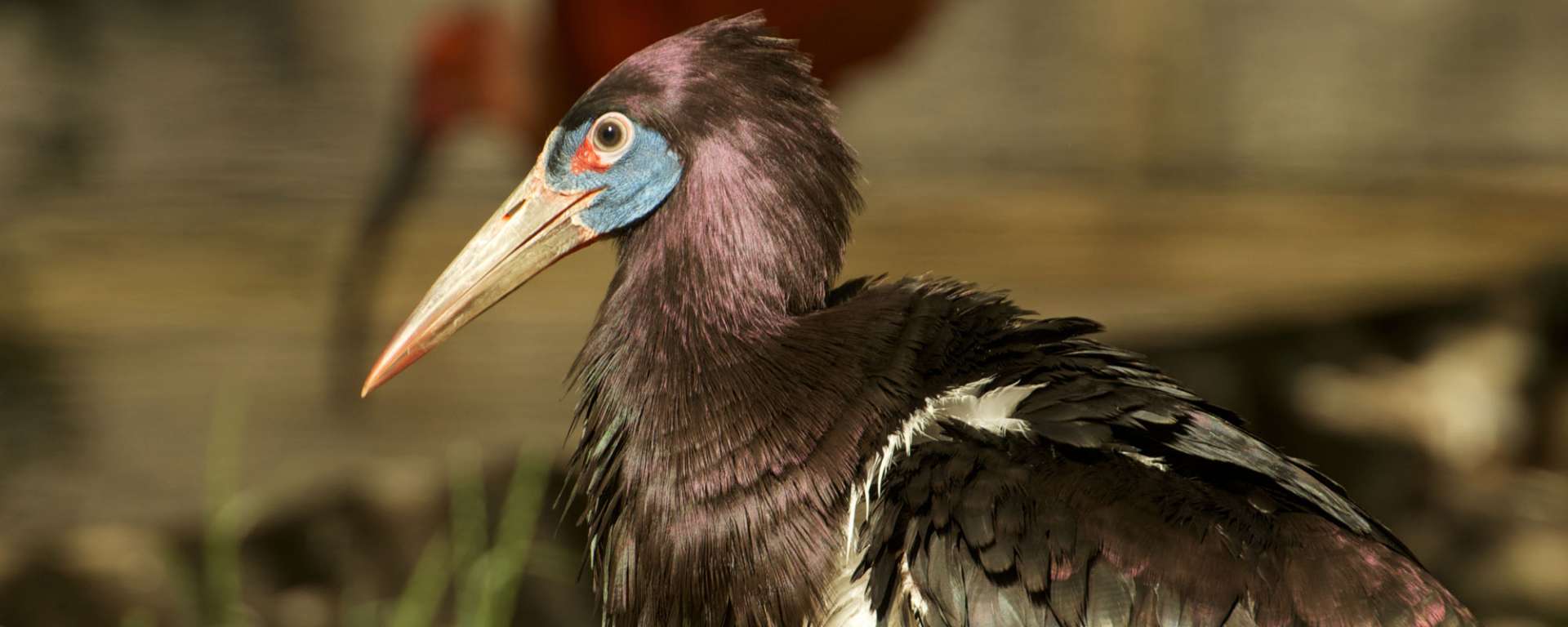Description
The upper part of the body is glossy purple and green; the belly is white. The skin on the face is dark blue, with a red ring around the eye. Legs are greyish with red knees and feet.
Classification
- Class
- Aves
- Order
- Ciconiiformes
- Family
- Ciconiidae
- Genus
- Ciconia
- Species
- C. abdimii
- Conservation Status
- Least Concern
Key Facts
- Height
- 80 cm (about 31 inches)
- Weight
- 1.3 kg (2.8 pounds)
Social Life
White-bellied storks are gregarious and are often found in flocks of up to 10,000 birds. They are mainly active during the day; in hot weather, they hunt earlier in the morning and later in the evening. They spend a lot of time preening and head-scratching to care for their feathers. Storks are not vocal birds; they may make some sounds such as a hiss or honk or beak clatter at breeding sites. They tend to communicate more by visual displays, such as the “up-down” head bob that serves to strengthen pair-bonds.
Habitat and Range
Usually found in open grasslands, but may also be found in cultivated areas. They live mainly in South and East Africa but migrate north of the Equator to nest.
Diet
Unlike other stork species, Abidm’s Storks eat almost exclusively insects, especially locusts, swarming caterpillars of army worms, grasshoppers and crickets. They occasionally eat small aquatic animals or mice. Large flocks congregate when insects swarm or at grass fires, where they gorge themselves on the fleeing insects.
Lifespan
About 20-30 years.
Predators
Because of the colonial nesting, eggs and chicks are not too vulnerable to predators such as snakes and hawks. Human interaction with storks is usually benign. Habitat loss is the main concern.
Reproduction
White-bellied storks become sexually mature about 3-5 years. The breeding season is early in the rainy season, typically May. They nest in colonies in trees or cliffs, often with other species, including Yellow-billed storks, Marabous, Pink-backed Pelicans, herons, ibis, cormorants and egrets. White-bellied storks typically build a stick nest, with other material woven in. Usually the male brings the material and the female weaves it in. Because they are considered to be “good luck birds” they often nest in the roofs of native huts or other buildings and are welcomed by the inhabitants.
The female lays 2-3 eggs. Chicks hatch after about 30 days and are covered with grey down. Both parents care for the chicks. Food is regurgitated onto the nest floor, where chicks eagerly eat it. They fledge at about 50-60 days.
- Information
-
Description
The upper part of the body is glossy purple and green; the belly is white. The skin on the face is dark blue, with a red ring around the eye. Legs are greyish with red knees and feet.
Classification
- Class
- Aves
- Order
- Ciconiiformes
- Family
- Ciconiidae
- Genus
- Ciconia
- Species
- C. abdimii
- Conservation Status
- Least Concern
Key Facts
- Height
- 80 cm (about 31 inches)
- Weight
- 1.3 kg (2.8 pounds)
- Lifestyle
Social Life
White-bellied storks are gregarious and are often found in flocks of up to 10,000 birds. They are mainly active during the day; in hot weather, they hunt earlier in the morning and later in the evening. They spend a lot of time preening and head-scratching to care for their feathers. Storks are not vocal birds; they may make some sounds such as a hiss or honk or beak clatter at breeding sites. They tend to communicate more by visual displays, such as the “up-down” head bob that serves to strengthen pair-bonds.
Habitat and Range
Usually found in open grasslands, but may also be found in cultivated areas. They live mainly in South and East Africa but migrate north of the Equator to nest.Diet
Unlike other stork species, Abidm’s Storks eat almost exclusively insects, especially locusts, swarming caterpillars of army worms, grasshoppers and crickets. They occasionally eat small aquatic animals or mice. Large flocks congregate when insects swarm or at grass fires, where they gorge themselves on the fleeing insects.
Lifespan
About 20-30 years.
Predators
Because of the colonial nesting, eggs and chicks are not too vulnerable to predators such as snakes and hawks. Human interaction with storks is usually benign. Habitat loss is the main concern.
Reproduction
White-bellied storks become sexually mature about 3-5 years. The breeding season is early in the rainy season, typically May. They nest in colonies in trees or cliffs, often with other species, including Yellow-billed storks, Marabous, Pink-backed Pelicans, herons, ibis, cormorants and egrets. White-bellied storks typically build a stick nest, with other material woven in. Usually the male brings the material and the female weaves it in. Because they are considered to be “good luck birds” they often nest in the roofs of native huts or other buildings and are welcomed by the inhabitants.The female lays 2-3 eggs. Chicks hatch after about 30 days and are covered with grey down. Both parents care for the chicks. Food is regurgitated onto the nest floor, where chicks eagerly eat it. They fledge at about 50-60 days.

